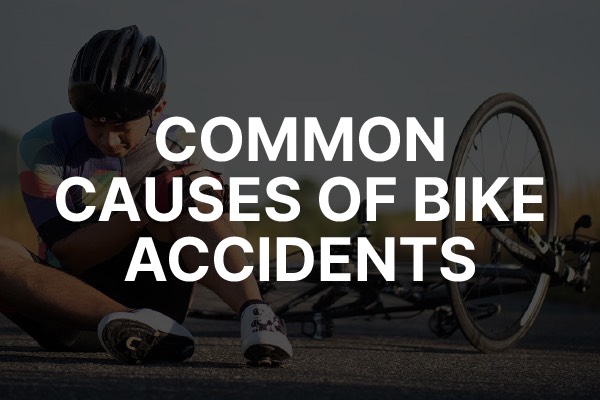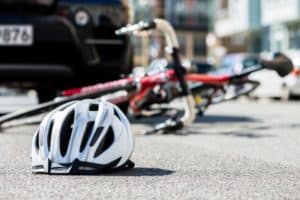
When someone riding a bike gets hit by a car, it’s never just a “bike accident.” It’s a life-altering event. You or your loved one may now be dealing with serious injuries, lost income, mounting medical bills, or even lasting trauma. These setbacks change everything. You might be left wondering how something so avoidable could cause so much damage.
Many of the common causes of bicycle accidents involve preventable driver behavior, like distracted driving, speeding, or failure to yield. This is particularly true in the Dallas-Fort Worth Metroplex. In fact, Dallas, Tarrant, Collin, and Denton are among the top ten counties in Texas with the highest number of bicycle accidents per year. If you or a loved one has been injured, an experienced Arlington, TX Bicycle Accident Attorney can help you protect your rights and pursue the compensation you deserve.
Key Takeaways
- Dallas, Tarrant, Collin, and Denton counties consistently rank among the top ten in Texas for reported bicycle accidents.
- Most bicycle accidents are caused by driver negligence, especially distracted driving, speeding, and failure to yield to cyclists.
- Even low-speed crashes can result in catastrophic injuries for bicyclists, including traumatic brain injuries and spinal damage.
- Many drivers overlook or violate traffic laws that protect cyclists, especially at intersections and in bike lanes.
- Unsafe road design, poor maintenance, and illegal parking create daily hazards that put cyclists at risk.
- After a bicycle accident, having a skilled personal injury lawyer levels the playing field and helps you fight for full compensation.
The Most Common Causes of Bicycle Accidents
Most bicycle crashes happen because a driver wasn’t paying attention, violated traffic laws, or failed to share the road. Those actions, whether careless or aggressive, can leave cyclists with devastating injuries and long-term consequences. Here’s a closer look at some of the driver behaviors that often injure and kill bicyclists across the U.S.
Distracted Driving
Distracted drivers remain one of the top dangers to cyclists on the road. Whether it’s checking a phone, adjusting the GPS, or eating behind the wheel, these split-second distractions can be deadly. When a driver isn’t fully aware of their surroundings, they’re more likely to drift into a bike lane, miss a stop sign, or fail to notice a cyclist in the crosswalk.
Because bicycles are smaller and quieter than other vehicles, they’re often overlooked in a distracted driver’s field of view. And when a crash occurs, it’s the cyclist without the protection of a steel frame or airbags who absorbs the full impact.
Failure to Yield
Intersections, roundabouts, and driveways are high-risk areas where drivers must yield to cyclists. But many drivers either don’t know the same rules apply or assume a bicycle must yield to them. This leads to dangerous scenarios where a driver makes a turn across a cyclist’s path or merges into a bike lane without looking.
When a driver fails to yield, even a low-speed impact can lead to severe injuries such as broken bones, head injuries, and internal trauma.
Unsafe Road Conditions
Even when no other vehicle is involved, unsafe roadways play a significant role in bicycle crashes. Poorly maintained streets, potholes, loose gravel, and debris in the bike lane can cause a rider to lose control. In urban areas, construction zones without proper signage also increase the risk of accidents.
Government entities responsible for maintaining safe road conditions may also be held liable in some of these cases.
Speeding
Speeding drivers reduce their own reaction time and dramatically increase the likelihood of catastrophic injuries if a collision happens. The faster a vehicle moves, the harder it is to stop in time if a cyclist is crossing the street or making a left turn. High-speed impacts can cause traumatic brain injuries, spinal cord damage, or worse.
School zones and residential streets are especially dangerous for bike riders when drivers don’t slow down.
Dooring Accidents from Parked Cars
One of the most preventable yet common causes of bicycle accidents involves parked cars. When a driver or passenger opens their door into a cyclist’s path without checking, the result can be a high-impact crash. The cyclist may be thrown off the bike or forced into moving traffic to avoid the door.
This type of incident is especially common in cities like New York, San Francisco, and across urban areas in Texas, where parked cars line narrow streets and bike lanes run alongside them.
Impaired Driving

Alcohol and drugs impair judgment, slow reaction times, and increase the likelihood that a driver will miss a cyclist altogether. Some of the most tragic bike accidents we’ve seen involved impaired drivers who ran red lights, drifted into bike lanes, or veered onto sidewalks.
While driving under the influence is illegal, it continues to be a leading factor in fatal and life-threatening crashes involving bicyclists in the Lone Star State and across the U.S..
Injuries Cyclists Commonly Sustain in Accidents
When bicycle accidents happen, they often result in severe injuries due to the lack of protection a bike offers. Even when wearing a helmet and reflective clothing, cyclists are still vulnerable.
Some of the most common injuries include:
- Traumatic brain injuries (TBI) While bike helmets offer some protection, they can’t fully prevent the effects of a direct blow to the head or a violent impact that may cause long-term cognitive, emotional, or physical impairments.
- Fractured bones, including the wrists, arms, ribs, and pelvis, are common in bicycle accidents and can require surgery, immobilization, and months of physical therapy to fully recover.
- Spinal cord injuries can range from herniated discs to permanent damage that causes partial or complete paralysis, often requiring lifelong medical care and major changes to a person’s independence and mobility.
- Internal injuries and organ damage may not be immediately visible after a crash but can include life-threatening conditions like internal bleeding, punctured lungs, or abdominal trauma that demand urgent surgical intervention.
- Road rash, lacerations, and scarring happen when a cyclist’s body scrapes across the pavement, often resulting in deep wounds that carry a high risk of infection and may leave permanent disfigurement or nerve damage.
Catastrophic injuries can lead to lifelong disabilities, requiring surgeries, rehabilitation, and home modifications
Serious Bike Accidents Affect Every Part of Your Life
A bicycle accident doesn’t just injure your body. It can interrupt your job, damage your independence, and create mental trauma that lingers for months or years. Cyclists often report anxiety, depression, or a loss of confidence in everyday activities after being hit by a vehicle.
In personal injury cases, it’s not just about calculating medical bills. An experienced attorney will pursue maximum compensation for everything you’ve suffered and lost, both economic and non-economic. This can include your lost wages or income, emotional distress, reduced quality of life, and future care needs.
What To Do After a Bicycle Accident
If you’ve already gotten medical attention, there are still important steps you can take to protect your rights and improve your chances of securing compensation.
- Hire a personal injury lawyer: An experienced bicycle accident lawyer protects your interests and allows you to focus on recovery while your attorney handles everything else.
- Follow through on medical treatment: Keep all appointments, follow your doctor’s advice, and keep detailed records. Gaps in care can hurt your case.
- Document your experience: Consider keeping a written or video journal of your pain levels, emotional impact, and physical limitations.
- Preserve your gear: Keep your damaged bicycle, helmet, reflective gear, and clothing. These can serve as important evidence.
- Avoid social media: Don’t post about the accident or your injuries online. Insurance companies may use this against you.
How Traffic Laws Affect Bicycle Safety
Both drivers and cyclists are expected to follow the same rules of the road. In fact, most states, including Texas, require bicyclists to obey stop signs, red lights, lane markings, and other traffic laws like any other vehicle. The problem arises when drivers either ignore these laws or assume they don’t apply to bikes.
Too many motorists still treat cyclists as second-class users of the road. This leads to behaviors like aggressive driving, cutting off a cyclist when turning, blocking bike lanes, or failing to yield at crosswalks. Whenever a driver makes one of these decisions without paying attention to their surroundings, it increases the risk of a crash.
Cyclists can do everything they can to remain safe on the road, but unfortunately, they cannot completely prevent a collision with a negligent driver.
The Role of Urban Infrastructure and Bike Lanes
Urban areas present unique hazards for bike riders. Busy intersections, dense traffic, and limited bike infrastructure all combine to make cities more dangerous for cyclists. In places like the Dallas-Fort Worth Metroplex, even roads that include a designated bike lane can become hazardous when drivers drift over the line or use the lane to turn or park illegally.
Many urban bike accidents happen when city infrastructure doesn’t fully account for bicyclist safety. Poor visibility at intersections, confusing lane markings, and a lack of protected bike lanes make crashes more likely. These are factors that often go unaddressed until someone gets seriously hurt.
To increase bicyclist safety, city planners and transportation departments must invest in safer infrastructure. But until that happens, it’s important for motorists of all types to stay fully aware of their surroundings and respect the cyclist’s right to use the road.
Common Bicycle Accident Scenarios
Bicycle accidents take many forms, but certain crash types appear again and again—often tied to driver negligence that leaves cyclists seriously injured.
- Right hook crashes: When a driver passes a cyclist on the left and then makes a right turn directly in their path.
- Left cross accidents: A vehicle turning left across traffic hits an oncoming cyclist going straight.
- Dooring: A car door is opened into the cyclist’s path without checking.
- Rear-end collisions: A driver following too closely hits a cyclist from behind, often at intersections or stop signs.
- Driveway exits: Cars exiting parking lots or driveways fail to look for bikes before pulling into the street.
In nearly all of these cases, the driver is either distracted, rushing, or unaware of their responsibility to yield.
What Compensation Can You Get in a Bike Accident Case?
Victims of serious bicycle accidents need more than a quick insurance payout. When another person’s negligence caused the crash, you may be entitled to compensation that covers far more than just your immediate medical bills.
A personal injury claim can help recover damages for:
- Emergency care and hospitalization
- Ongoing medical treatments and surgeries
- Physical therapy or rehabilitation
- Lost wages and loss of future income
- Pain and suffering
- Emotional distress or trauma
- Permanent disability or disfigurement
In fatal cases, surviving family members may also have grounds for a wrongful death claim to pursue justice for their loved one.
FAQs: Bicycle Accidents and Your Legal Options
How long do I have to file a claim after a bicycle accident?
Each state has a statute of limitations for filing personal injury and wrongful death lawsuits. in Texas, the deadline is generally two years from the date of the accident. However, it’s best to act quickly so evidence doesn’t go missing or get lost.
What if I wasn’t wearing a helmet at the time of the crash?
You can still file a claim even if you weren’t wearing a helmet. The at-fault party may argue that this contributed to your injuries, but it does not prevent you from pursuing compensation.
Can I file a claim if I was partially at fault?
In most states, yes, usually as long as your percentage of fault falls below a legal threshold. In Texas, the modified comparative fault rule allows you to recover damages as long as you were less than 51% at fault, but your compensation may be reduced based on your percentage of responsibility. Certain states have stricter or more lenient rules. Your bike accident lawyer can explain how these laws affect your case.
What if the driver left the scene of the accident?
If the crash was a hit-and-run, you may still be able to pursue compensation through your own uninsured motorist coverage or other avenues. A lawyer can help investigate and track down available coverage.
Do I really need a lawyer for a bike accident case?
Yes. Insurance companies often downplay injuries or shift blame to the cyclist. An experienced personal injury attorney can fight to hold the right party accountable and maximize your compensation.
Contact Branch & Dhillon After a Bicycle Accident

If you or a loved one has suffered serious injuries in a bicycle accident in the Dallas-Fort Worth area or anywhere in Texas, you don’t have to deal with the legal system alone. At Branch & Dhillon, trusted personal injury attorneys in Arlington, TX, we’ve spent years helping injured cyclists recover physically, emotionally, and financially.
We care deeply about our clients because we’ve seen what these accidents do—how they disrupt lives, create financial strain, and put families under immense stress. That experience drives us to fight harder. When we take your case, we pursue maximum compensation and handle every legal detail so you can focus on healing.
Call Branch & Dhillon today at (817) 533-3430 or contact us online for a free consultation. There’s no fee unless we win. Let us help you take the next step toward justice and recovery.

